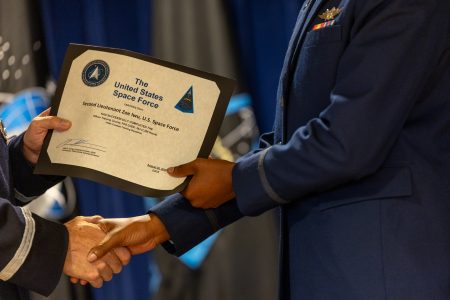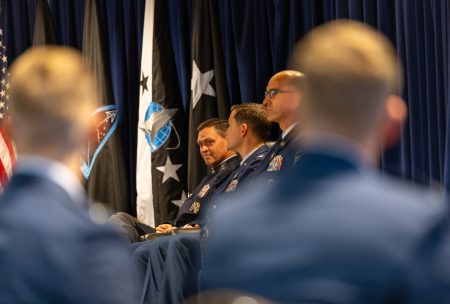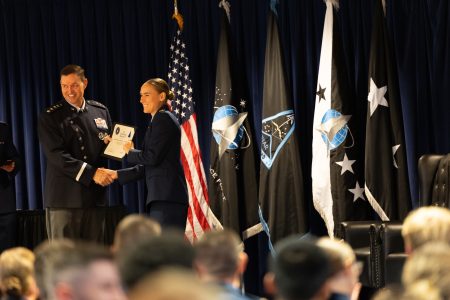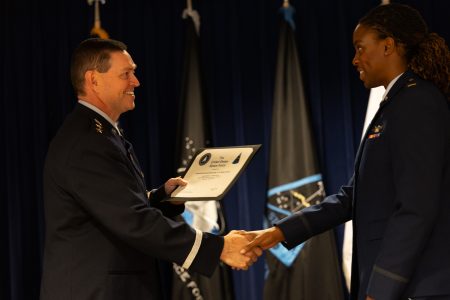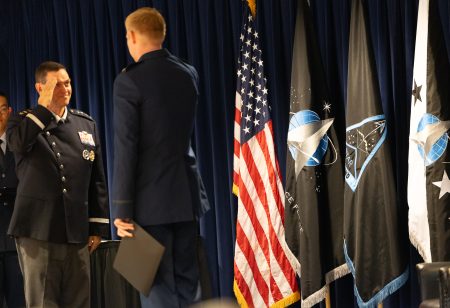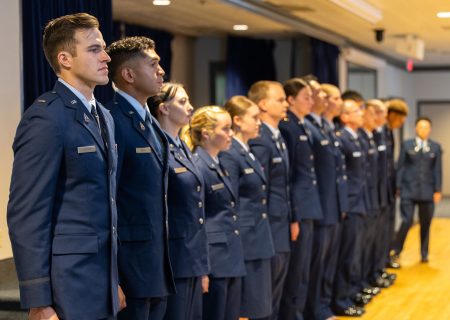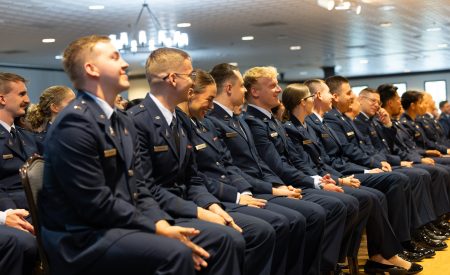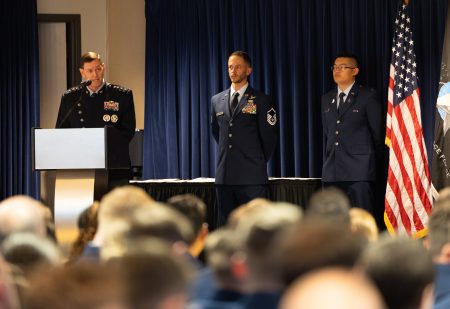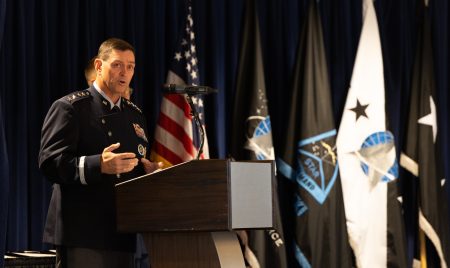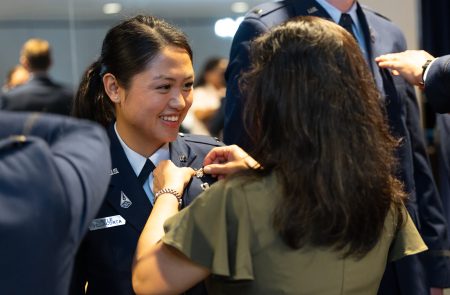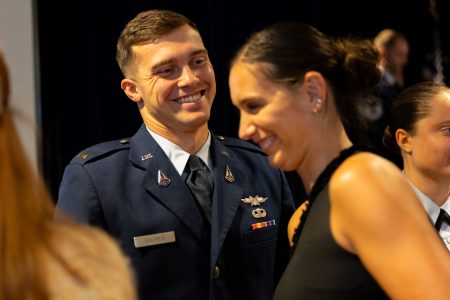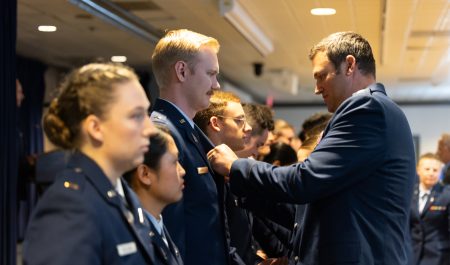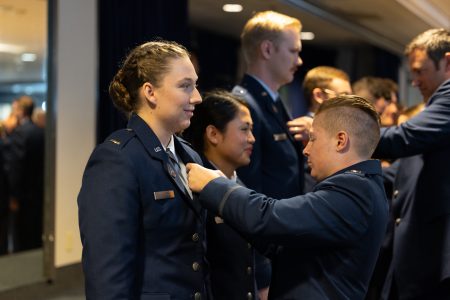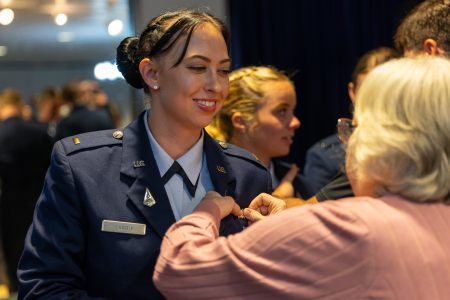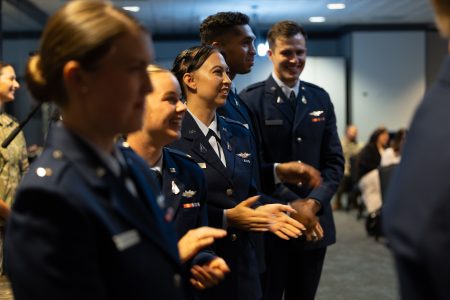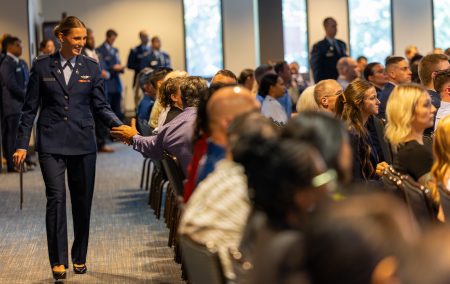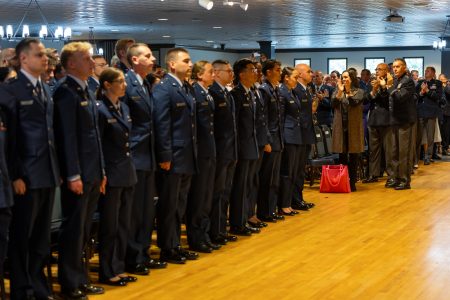PETERSON SPACE FORCE BASE, Colo.—The Space Force welcomed its first officers trained in a way far different from decades of Air Force practice late last month.
Eighty-four space professionals graduated from the Space Force’s first Officer Training Course on Aug. 28, a yearlong program in which Guardians were trained in all aspects of the service’s mission rather than a single specialty.
“We designed the training course the way the Space Force needs it to be done to meet Space Force needs,” Chief of Space Operations Gen. B. Chance Saltzman said. “We’re too small to really specialize and gain the benefits. … We don’t have the same scale; our officers have to do a lot more.”
The nearly six-year-old Space Force is unlike other services in the U.S. military. It is by far the smallest, with roughly 10,000 uniformed Guardians. Most of its members are deployed in place, and none are present in the domain in which they operate.
The service’s career fields can be counted on one hand, with just a handful of job specialties for officers: space operations, intelligence, cyber operations, and acquisitions.
So unsurprisingly, officials decided to try something very new with how they prepared officers to join the workforce just after comissioning, Saltzman told Air & Space Forces Magazine aboard a military aircraft as he traveled back to Joint Base Andrews, Md., outside of Washington, after handing out the first graduation certificates to the Guardians at Peterson.
“It marks a transition point,” Saltzman said. “We’ve now taken ownership, at least at this point, of our officer training, and it’s purposefully designed for what the Space Force needs. It’s not a composite of what other services have put together. It’s what we do.”
Recalling his own experience as a young missileer in the Air Force, Saltzman said his training then was different because he did not need to be familiar with the full scope of the Air Force’s operations.
“I did missile training for four months, and then I went straight to the missiles. I didn’t learn anything about the Air Force,” Saltzman said. “ICBM operations don’t have to integrate with fighter jets. You just do ICBM operations.”
But space operations are different, and its training course is meant to be different too. It was designed by the Space Force for the Space Force and did not rely on training models adapted from other branches or carried out by the Air Force.
“If you’re trying to do satellite operations, and you don’t understand how the ground networks work, if you don’t understand how the data is moved around after it’s connected, if you don’t understand the intelligence threat, because to some degree it’s ‘out of sight, out of mind’ you’re not going to be able to visualize it—if you don’t understand how all that works, you just can’t do your job.”
Saltzman said he has been thinking about overhauling officer training since he first took over as Chief of Space Operations some three years ago, driven by the rapid militarization of space. The first official move to establish the Officer Training Course was made in spring 2024.
“I realized that the way we were training those officers is insufficient, and why are we just rushing them through three months of training and throwing them in the field?” Saltzman said.
The training course is divided into several phases. The first 26 days of instruction are devoted to “Guardian Fundamentals,” which means joint U.S. military doctrine, Space Force doctrine, leadership skills, and planning.
“How the United States fights their wars, understanding that from the very beginning, instilling foundational knowledge from the very beginning, it gives the new officer accession a broader view of how space power plays a bigger role in military operations,” said Maj. Gerardo Andujar-Siaca, the director of operations for the 319th Combat Training Squadron, which runs the course.
The next nine months are divided into three sections: Space Operations, Intelligence, and Cyber—the major Guardian career fields. The last three weeks are devoted to a capstone exercise for Guardians to prove what they learned.
During the course of their training, Guardians learn how to conduct and combat space electronic warfare, conduct missile warning and defense, oversee space domain awareness, and how to conduct “orbital warfare,” according to an overview of the course provided by Space Training and Readiness Command.
Guardians also are taught how to produce intelligence products, including through JIPOE, the Joint Intelligence Preparation of the Operational Environment. Learning about offensive and defensive cyber techniques and artificial intelligence is also an essential part of the course, as is studying the acquisition process.
“As they go through the program, they’re identifying gaps, vulnerabilities of space power,” Andujar-Siaca said. “Then apply the tools that the acquisition community has at their disposal to address those vulnerabilities, gaps, and limitations that they have identified throughout the year. … If they choose to go and do acquisitions, now they go with an understanding of how the operations world in the Space Force works and what they need.”
The head of STARCOM, Maj. Gen. James E. Smith, recalled how his experience in acquisitions helped him as a space operator earlier in his career, and why that was important for future Guardians.
“We can’t buy an airplane, go fly it, and test it, and then go back and do maintenance on it or upgrades to it,” Smith said. “We buy it, we launch it, and so the integration of the acquisition community with the operations community becomes very important. So the fundamental theme I would put across and why OTC is important, is the integration of skill sets.”
Roughly a quarter of the service’s more than two dozen generals were in attendance at the graduation ceremony, including Saltzman and his new No. 2, Vice Chief Gen. Shawn N. Bratton, a testament to the importance and outsize impact of the graduates given the small size of the service.
2nd Lt. Chris Wysong, who graduated from the course on Aug. 28, said the training has been very valuable and that the perspective of the students was solicited as the service seeks to strengthen the course for the next class.
“I think overall it has been a great experience,” said Wyson, who is heading to the 22nd Space Operations Squadron, which handles satellite command and control. “They were hungry for feedback.”
Some 360 students are training in six cohorts now, and the course is built to teach 480 students.
“The idea was to get something in place and start practically experimenting with it,” Saltzman said. “Get the feedback from the students, get the feedback from the instructors. They’ll have a visceral reaction because they had to live through it in the feedback.”
After graduation, family members, friends, and other Guardians pinned the temporary OTC badge on each of the students—a clear highlight of the day for service members and those in attendance. A permanent badge is still in development.
“The space badge is actually an Air Force badge,” Saltzman said. “So it was an opportunity to kind of break from that and say, ‘Wait a minute. Yeah, we pulled that heritage over, but we were doing something different and unique. So let’s reward something different.’ … We had a career field that was abandoned by the Air Force called multi-domain warfare officer. And I said, ‘Well, we’re training space and cyber. How is this not a multi-domain warfare officer?”
Smith said one day, that more homogeneous approach could be vital to the service. Asked by Air & Space Forces Magazine what the downside of not adopting a model such as the Officer Training Course could be, Smith said, “I think you could make an argument that we probably lose in a space conflict.”
“As the character of warfare is changing and the speeds at which activities are going to occur in all domains, but especially in the space domain, stovepiped activities that aren’t integrated at the speed and pace of space warfare will be too slow to make a difference,” Smith said.

